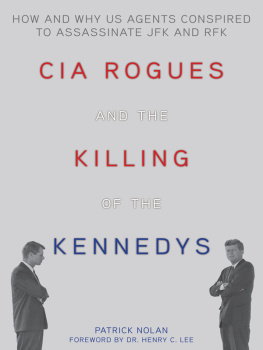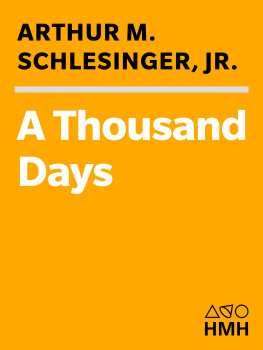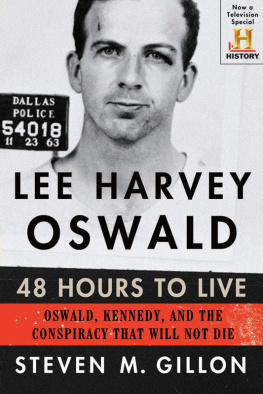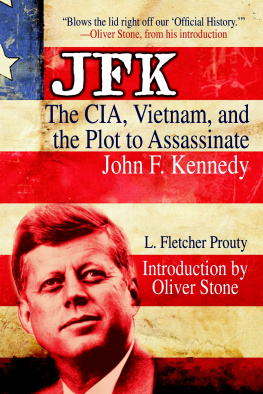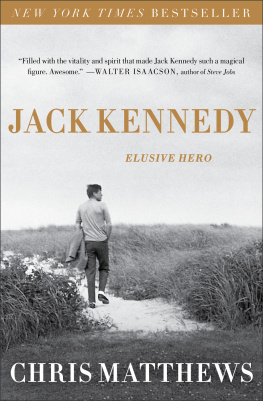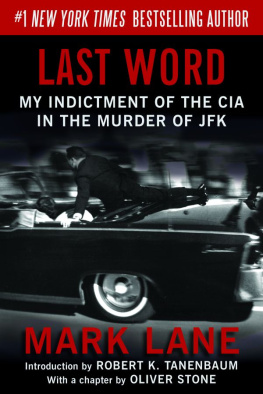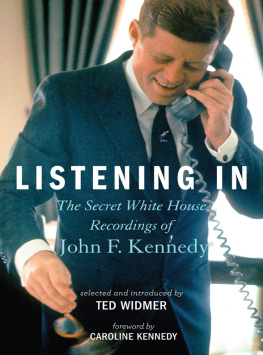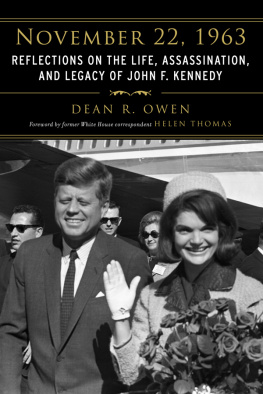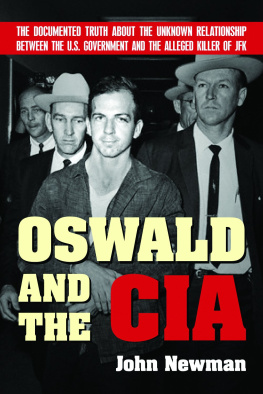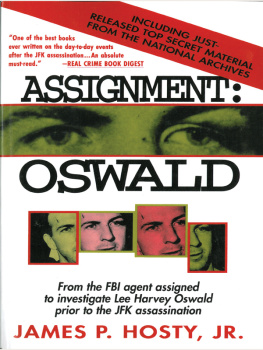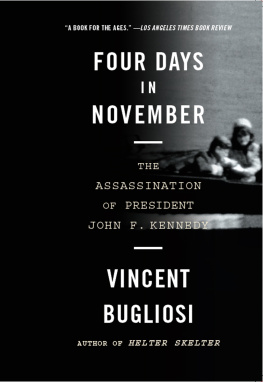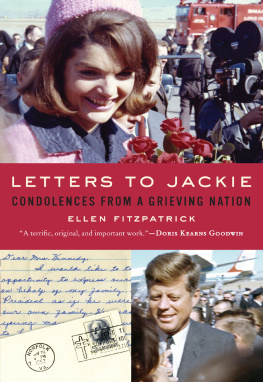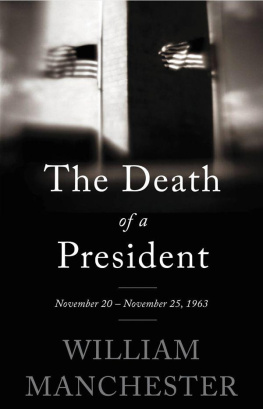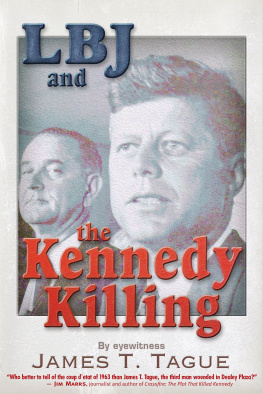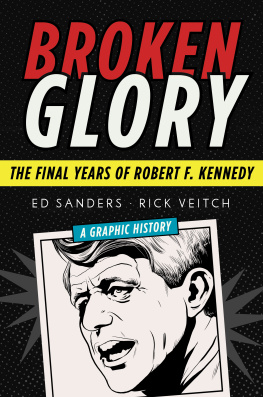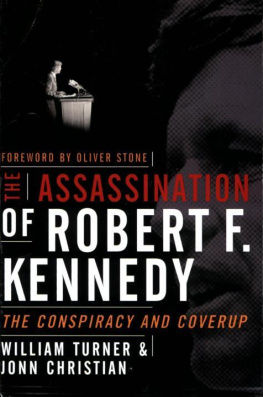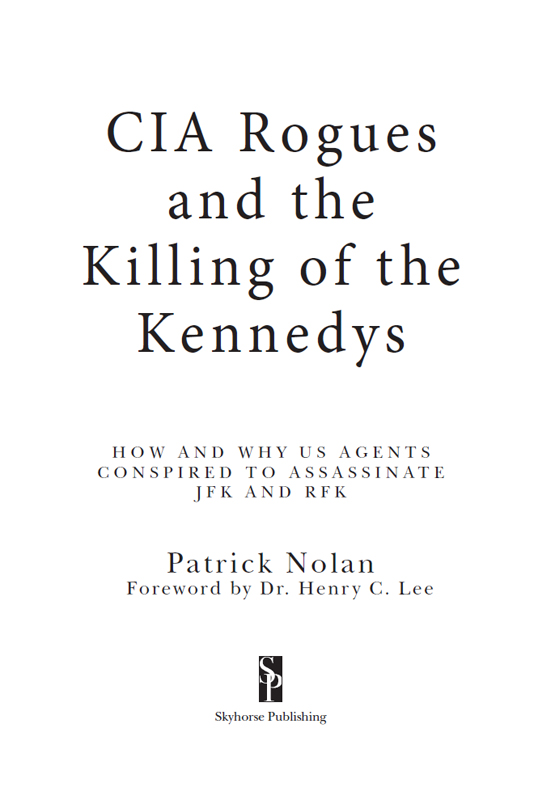Copyright 2013 by Patrick Nolan
All Rights Reserved. No part of this book may be reproduced in any manner without the express written consent of the publisher, except in the case of brief excerpts in critical reviews or articles. All inquiries should be addressed to Skyhorse Publishing, 307 West 36th Street, 11th Floor, New York, NY 10018.
Skyhorse Publishing books may be purchased in bulk at special discounts for sales promotion, corporate gifts, fund-raising, or educational purposes. Special editions can also be created to specifications. For details, contact the Special Sales Department, Skyhorse Publishing, 307 West 36th Street, 11th Floor, New York, NY 10018 or .
Skyhorse and Skyhorse Publishing are registered trademarks of Skyhorse Publishing, Inc., a Delaware corporation.
Visit our website at www.skyhorsepublishing.com.
10 9 8 7 6 5 4 3 2 1
Library of Congress Cataloging-in-Publication Data
Nolan, Patrick (Patrick Thomas)
CIA rogues and the killing of the Kennedys : how and why US agents conspired to kill JFK and RFK / Patrick Nolan.
pages cm
Includes bibliographical references and index.
ISBN 978-1-62636-255-0 (alk. paper)
1. Kennedy, John F. (John Fitzgerald), 1917-1963Assassination. 2. Kennedy, Robert F., 1925-1968Assassination. 3. United States. Central Intelligence AgencyCorrupt practices. 4. United States. Central Intelligence AgencyHistory20th century. 5. ConspiraciesUnited StatesHistory20th century. I. Title.
E842.9.N64 2013
973.9220922dc23
2013024614
ISBN: 978-1-62873-450-8
Printed in the United States of America.
A CKNOWLEDGMENTS

I ESPECIALLY WANT to thank noted forensic scientist Dr. Henry C. Lee of Connecticut, without whom this work would not have been accomplished, and Arthur M. Schlesinger Jr., who encouraged me to keep writing. I wish to recognize investigators William W. Turner and Prof. Philip H. Melanson for their advice and assistance. My thanks also to Judge Robert J. Joling and Profs. Robert M. Hendrick and Maura Flannery. Archivists Judy Farrar, Misty Fitch, Rosemary Grossman, Nancy Zimmelman, Jessica Herrick, Mark Davies, Michael Levenstein, Rex Bradford, and the Mary Ferrell Foundation were especially helpful. I thank attorney Larry Teeter for his help, as well as attorney Gregory St. John. Others whom I greatly appreciate are my agent Grace Freedson, Bill Wolfsthal, Wesley Jacques, Emily Houlihan, and Lauren Burnstein at Skyhorse Publishing, and Peter Kilduff, Taivo Raig, and Tony Calabrese. And last, but not least, Theresa L. Nolan, John W. Nolan, Aideen F. Nolan, Patrick and Leanne Nolan, Mary and Andrew Fracchia, Joseph Nolan, and Bella Pangur Ban.
D EDICATION


To Aideen
T ABLE OF C ONTENTS

F OREWORD

by
Dr. Henry C. Lee
F ROM A FORENSIC science point of view, there is much to be learned from the 1960s assassinations of President John F. Kennedy and New York senator Robert F. Kennedy. In both cases, these men were killed at the peak of their popularity. While many have ascribed these murders to lone assassins, forensic evidence reveals inconsistencies, unanswered questions, and the likelihood of unaccounted-for gunmen.
The job of a responsible forensic scientist or criminalist is to reconstruct, if possible, how a particular crime took place. This determination is based on the available physical evidence. It is not the role of the forensic expert to speculate regarding the identity of those who may have been behind a crime or the planning of it. The professional forensic scientist leaves this part of the equation to the detectives and the justice system. We can only collect, analyze, and present the best evidence. It is up to others to draw conclusions from the body of evidence.
For more than forty years, I have investigated thousands of cases, both in my home base, Connecticut, and around the world. Through my work at the Connecticut State Police Forensic Science Laboratory and at the University of New Havens Henry C. Lee Institute of Forensic Science, I have been fortunate to have had the opportunity to assist many people to find justice for their loved ones.
The Kennedy cases have intrigued forensic scientists throughout the decades since these assassinations befell America in the 1960s. The assassination of President Kennedy on November 22, 1963 in Dallas, Texas, is examined in my book Famous Crimes Revisited , coauthored with Dr. Jerry Labriola. My analysis of the evidence and studies conducted by other respected forensic scientists reveal that the bullet evidence, the ballistics, and the autopsy findings point away from the official Warren Commission version. More recently, I participated in the 2008 national symposium at the Cyril H. Wecht Institute of Forensic Science and Law at Duquesne University in Pittsburgh, Pennsylvania. At the conference, new bullet evidence was presented. The results of neutron activation (exact composition in parts per billion) of fragments recovered from the JFK assassination showed no matchthat is, the batches of shells were different. This is an indication of a high probability that more than one weapon was fired.
In the assassination of Sen. Robert Kennedy, major inconsistencies also exist in the physical evidence recovered at the scene. The shooting took place as the senator walked through a crowded hotel kitchen pantry following his presidential primary election victory speech at Los Angeless Ambassador Hotel on June 5, 1968. Kennedy was shot at point-blank range in the back of the head. However, the alleged gunman was firing from the front at a distance of several feet.
In the summer of 2002, one of the foremost experts on the case, Judge Robert Joling, donated his entire RFK assassination collection to the University of New Havens Henry C. Lee Institute of Forensic Science archives. From Judge Jolings documents and photographs, it is clear that the ballistics and autopsy evidence in the case conflict with the official version of events. While dozens of eyewitnesses saw twenty-four-year-old Palestinian immigrant Sirhan Sirhan fire a .22 caliber handgun at Senator Kennedy, the physical evidence reveals a different story.
But such evidence alone cannot tell us why a crime occurred or how a plot developed.
In this latest work on these cases, author Patrick Nolan presents the culmination of more than a decade of research, much of which he has shared with me over the years. His thesis is backed up with compelling evidence and thorough documentation. He has taken what some considered to be open-and-shut cases and, through diligent analysis of facts and the evidence, has found some new answers to the questions surrounding the violent attempts to subvert the national will in the 1960s.
Mr. Nolans early background in news writing and college teaching and his perseverance and devotion to this subject have given him the tools to make sound judgments in these controversial cases.
The goal of forensic science professionals is to find the truth. This is also Mr. Nolans goal. At the end of the day, it is up to the reader to draw his or her own conclusions based on the best evidence. At the same time, I firmly believeand I often remind myself and othersThe truth will always surface... someday.

